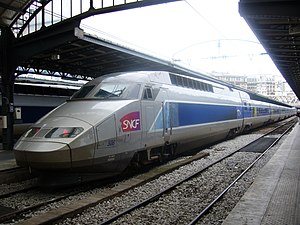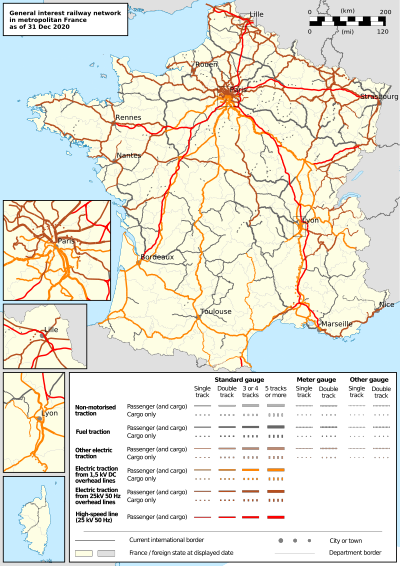| Rail transport in France | |||||
|---|---|---|---|---|---|
 TGV at Gare de l'Est in Paris. | |||||
| Operation | |||||
| National railway | SNCF | ||||
| Infrastructure company | SNCF Réseau | ||||
| Major operators | Thalys, TGV Lyria, Eurostar, RATP, Elipsos, ECR | ||||
| Statistics | |||||
| Ridership | 1.762 billion (2017, SNCF[1] and RATP sections of RER[2]) | ||||
| Passenger km | 100.2 billion (2017)[1][2] | ||||
| Freight | 33.6 billion tonne-km (2017, SNCF and competitors[3]) | ||||
| System length | |||||
| Total | 29,901 kilometres (18,580 mi) [4] | ||||
| Double track | 16,445 km (10,218 mi) | ||||
| Electrified | 15,140 km (9,410 mi) | ||||
| High-speed | 2,734 km (1,699 mi) (dedicated); 929 km (577 mi) (upgraded) | ||||
| Track gauge | |||||
| Main | 1,435 mm (4 ft 8+1⁄2 in) standard gauge | ||||
| High-speed | 1,435 mm (4 ft 8+1⁄2 in) | ||||
| Electrification | |||||
| 25 kV AC | 9,113 km (5,663 mi) | ||||
| 1.5 kV DC | 5,905 km (3,669 mi) | ||||
| other | 122 km (76 mi) | ||||
| Features | |||||
| No. tunnels | 1,300[5] | ||||
| Tunnel length | 540 km (340 mi) | ||||
| Longest tunnel | 50.5 km (31.4 mi) (Channel Tunnel) | ||||
| Longest bridge | 2.178 km (1.353 mi) (Saint-André-de-Cubzac bridge) | ||||
| No. stations | 3,054 (2009).[6] | ||||
| Highest elevation | 1,593m (Yellow Train) | ||||
| |||||
Rail transport in France is marked by a clear predominance of passenger traffic, driven in particular by high-speed rail. The SNCF, the national state-owned railway company, operates most of the passenger and freight services on the national network managed by its subsidiary SNCF Réseau. France currently operates the second-largest European railway network, with a total of 29,901 kilometres of railway.[4]
The first railway line in the country opened in 1827 from Saint-Étienne to Andrézieux. The network has undergone a major modernization since 1981 with the arrival of the TGV high-speed rail service which has been consistently expanded in subsequent years.
In 2017, there were 1.762 billion journeys on the French national rail network, among which 1.270 billion on SNCF services[1] and 493 million on RATP sections of the RER,[2] the express regional network operating in the Paris area which is shared between both companies. The Paris suburban rail services represents alone 82% of the French rail annual ridership.[1][2]
With a total of 100.2 billion passenger-kilometres,[1][2] France has the fifth-most used passenger network worldwide, and second-most used in Europe after that of Russia.[7] France is a member of the International Union of Railways (UIC). The UIC country code for France is 87.
At the same time, only 9% of French cargo is shipped via railway, or about ½ of the European average, and only a small fraction when compared to certain countries.
National and regional services (TER) are complemented by an important network of urban railways which is still rapidly growing. Six cities are served by metro systems (Lille, Lyon, Marseille, Paris, Rennes and Toulouse), while 31 metropolitan areas are additionally served by tram networks, among which 23 were inaugurated in the 21st century.
France was ranked 7th among national European rail systems in the 2017 European Railway Performance Index for intensity of use, quality of service and safety performance, a decrease from previous years.[8]
- ^ a b c d e "Memento statistiques SNCF Mobilités 2017" (PDF). La Plaine Saint-Denis, France: SNCF Mobilités. 2017. p. 14. Retrieved 2 May 2019.
- ^ a b c d e "Trafic annuel et journalier" (XLS). Paris, France: Observatoire de la mobilité en Île-de-France (Omnil). 2017. Retrieved 2 May 2019.
- ^ "Memento statistiques SNCF Mobilités 2017" (PDF). La Plaine Saint-Denis, France: SNCF Mobilités. 2017. p. 39. Retrieved 2 May 2019.
- ^ a b Cite error: The named reference
RFF_Statisticswas invoked but never defined (see the help page). - ^ "Rapport sur la sécurité des tunnels routiers et ferroviaires francais". www.assemblee-nationale.fr.
- ^ La Gare Contemporaine Archived 20 July 2011 at the Wayback Machine p94, Fabienne Keller
- ^ "Transport – Passenger transport – OECD Data". OECD.
- ^ "the 2017 European Railway Performance Index". Boston Consulting Group. 8 January 2021.
